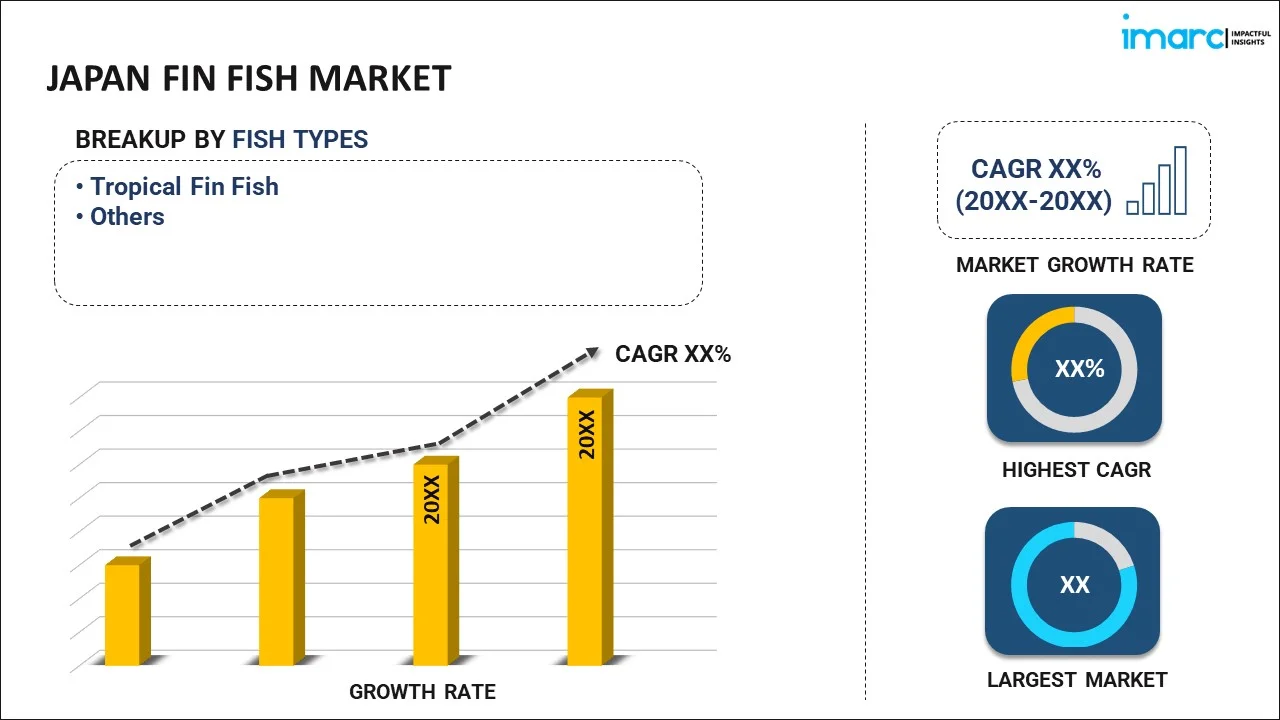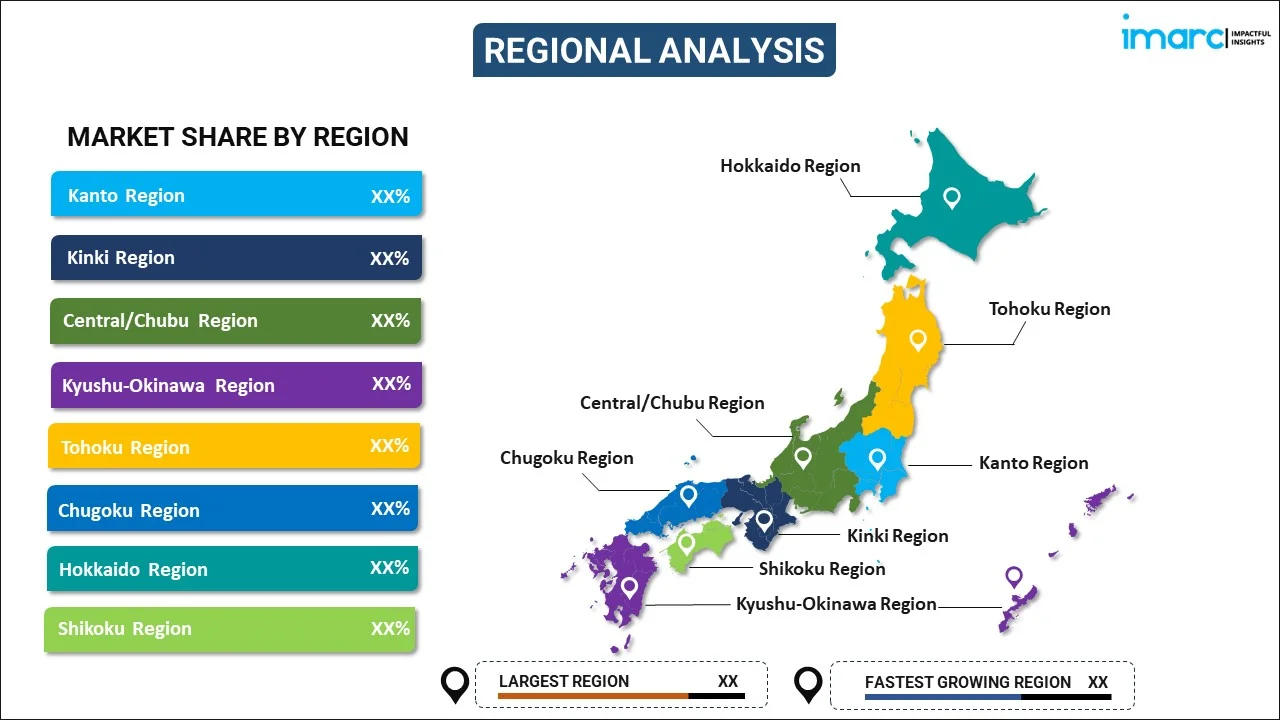
Japan Fin Fish Market Report by Fish Type (Tropical Fin Fish, and Others), Environment (Freshwater, Marine Water, Brackish Water), Distribution Channel (Supermarkets and Hypermarkets, Convenience Stores, Specialty Stores, Online Stores, and Others), and Region 2025-2033
Market Overview:
The Japan fin fish market size reached USD 11.9 Billion in 2024. Looking forward, IMARC Group expects the market to reach USD 16.3 Billion by 2033, exhibiting a growth rate (CAGR) of 3.6% during 2025-2033. The evolving gastronomic landscape, rapid technological advancements, increasing environmental concerns, the integration of real-time data analysis and growing sustainable aquaculture practices represent some of the key factors driving the market.
|
Report Attribute
|
Key Statistics
|
|---|---|
|
Base Year
|
2024 |
|
Forecast Years
|
2025-2033
|
|
Historical Years
|
2019-2024
|
| Market Size in 2024 | USD 11.9 Billion |
| Market Forecast in 2033 | USD 16.3 Billion |
| Market Growth Rate (2025-2033) | 3.6% |
A fin fish, or teleost fish, is a diverse group of vertebrate aquatic animals characterized by fins, which are appendages that aid in their movement and stability in water. These fish encompass various species in marine habitats, including oceans, rivers, lakes, and ponds. They display an array of shapes, sizes, colors, and behaviors, making them a significant component of aquatic ecosystems and a vital resource for human consumption and economic activities. They are a prominent source of animal protein for human diets, providing essential nutrients such as omega-3 fatty acids, vitamins, and minerals. The consumption of fin fish has been linked to improved cardiovascular health and brain function. The fishing industry relies heavily on these fish for commercial purposes, contributing to the economy and supporting the livelihoods of countless individuals involved in fishing, processing, and distribution. Finfish also contribute to aquatic ecosystems by controlling populations of prey species and maintaining a balanced food web.
Japan Fin Fish Market Trends:
The increasing demand for fin fish due to the evolving gastronomic landscape, and the increasing preference for nutritious and sustainable food choices, are major factors contributing to the market growth. Moreover, the growing consumption of fin fish due to their inherent health benefits and culinary adaptability, leading to the intersection of health consciousness and culinary excellence, is propelling the market growth. Additionally, rapid technological advancements and innovations within the fishing and aquaculture sectors, such as satellite-based tracking and remote sensing employed to locate fish populations more accurately, optimizing catch efforts and minimizing bycatch, elevating the availability and accessibility of diverse fin fish species is providing a considerable boost to the market growth. In confluence with this, the integration of real-time data analysis and predictive modeling empowering fishing fleets to make informed decisions regarding fishing grounds, seasonality, and migration patterns, ensuring a more targeted and responsible approach to fishing, is also strengthening the market growth. In addition to this, the increasing sustainable aquaculture practices that help reduce pressure on wild fish populations and provide a reliable source of seafood, is creating a positive outlook for the market growth. Furthermore, the integration of digital platforms and the growing e-commerce sector, facilitating convenient access to a wide range of fin fish products providing consumers with choices that extend beyond geographical constraints, and offering an extensive selection of fresh, frozen, and processed fin fish is providing remunerative growth opportunities for the market.
Japan Fin Fish Market Segmentation:
IMARC Group provides an analysis of the key trends in each segment of the Japan fin fish market report, along with forecasts at the country level for 2025-2033. Our report has categorized the market based on fish type, environment, and distribution channel.
Fish Type Insights:

- Tropical Fin Fish
- Pompano
- Snappers
- Groupers
- Salmon
- Milkfish
- Tuna
- Tilapia
- Catfish
- Seabass
- Others
- Others
The report has provided a detailed breakup and analysis of the market based on the fish type. This includes tropical fin fish (pompano, snappers, groupers, salmon, milkfish, tuna, tilapia, catfish, seabass, and others) and others.
Environment Insights:
- Freshwater
- Marine Water
- Brackish Water
A detailed breakup and analysis of the market based on the environment has also been provided in the report. This includes freshwater, marine water and brackish water.
Distribution Channel Insights:
- Supermarkets and Hypermarkets
- Convenience Stores
- Specialty Stores
- Online Stores
- Others
A detailed breakup and analysis of the market based on the distribution channel has also been provided in the report. This includes supermarkets and hypermarkets, convenience stores, specialty stores, online stores and others.
Regional Insights:

- Kanto Region
- Kinki Region
- Central/Chubu Region
- Kyushu-Okinawa Region
- Tohoku Region
- Chugoku Region
- Hokkaido Region
- Shikoku Region
The report has also provided a comprehensive analysis of all the major regional markets, which include Kanto Region, Kinki Region, Central/Chubu Region, Kyushu-Okinawa Region, Tohoku Region, Chugoku Region, Hokkaido Region, and Shikoku Region.
Competitive Landscape:
The report has also provided a comprehensive analysis of the competitive landscape in the market. Competitive analysis such as market structure, key player positioning, top winning strategies, competitive dashboard, and company evaluation quadrant has been covered in the report. Also, detailed profiles of all major companies have been provided.
Japan Fin Fish Market Report Scope:
| Report Features | Details |
|---|---|
| Base Year of the Analysis | 2024 |
| Historical Period | 2019-2024 |
| Forecast Period | 2025-2033 |
| Units | Billion USD |
| Scope of the Report | Exploration of Historical and Forecast Trends, Industry Catalysts and Challenges, Segment-Wise Historical and Predictive Market Assessment:
|
| Fish Types Covered |
|
| Environments Covered | Freshwater, Marine Water, Brackish Water |
| Distribution Channels Covered | Supermarkets and Hypermarkets, Convenience Stores, Specialty Stores, Online Stores, Others |
| Regions Covered | Kanto Region, Kinki Region, Central/Chubu Region, Kyushu-Okinawa Region, Tohoku Region, Chugoku Region, Hokkaido Region, Shikoku Region |
| Customization Scope | 10% Free Customization |
| Post-Sale Analyst Support | 10-12 Weeks |
| Delivery Format | PDF and Excel through Email (We can also provide the editable version of the report in PPT/Word format on special request) |
Key Questions Answered in This Report:
- How has the Japan fin fish market performed so far and how will it perform in the coming years?
- What has been the impact of COVID-19 on the Japan fin fish market?
- What is the breakup of the Japan fin fish market on the basis of fish type?
- What is the breakup of the Japan fin fish market on the basis of environment?
- What is the breakup of the Japan fin fish market on the basis of distribution channel?
- What are the various stages in the value chain of the Japan fin fish market?
- What are the key driving factors and challenges in the Japan fin fish market?
- What is the structure of the Japan fin fish market and who are the key players?
- What is the degree of competition in the Japan fin fish market?
Key Benefits for Stakeholders:
- IMARC’s report offers a comprehensive quantitative analysis of various market segments, historical and current market trends, market forecasts, and dynamics of the Japan fin fish market from 2019-2033.
- The research study provides the latest information on the market drivers, challenges, and opportunities in the Japan fin fish market.
- Porter's five forces analysis assist stakeholders in assessing the impact of new entrants, competitive rivalry, supplier power, buyer power, and the threat of substitution. It helps stakeholders to analyze the level of competition within the Japan fin fish industry and its attractiveness.
- Competitive landscape allows stakeholders to understand their competitive environment and provides an insight into the current positions of key players in the market.
Need more help?
- Speak to our experienced analysts for insights on the current market scenarios.
- Include additional segments and countries to customize the report as per your requirement.
- Gain an unparalleled competitive advantage in your domain by understanding how to utilize the report and positively impacting your operations and revenue.
- For further assistance, please connect with our analysts.
 Inquire Before Buying
Inquire Before Buying
 Speak to an Analyst
Speak to an Analyst
 Request Brochure
Request Brochure
 Request Customization
Request Customization




.webp)




.webp)












